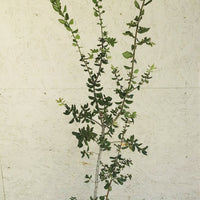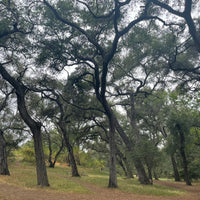

Quercus agrifolia, California oak
Quercus agrifolia, California oak
Tongva - weht
Kumeyaay - esnyaaw
Cahuilla - wi'asily
A slow growing tree that grows up to 80 feet tall and 35 feet wide. This plant produces a pollen that can produce an allergic reaction.
Prune in the summer, mid July to September. Young trees require pruning to establish a good branching system. Mature trees do not need to be pruned often, about every 5-10 years you should prune the dead small branches. Do not prune in the winter or spring.
These oaks prefer to have their roots shaded, plant with: (Baccharis pilularis), buckwheat(Eriogonum fasciculatum), Artemisia californica, toyon (Heteromeles arbutifolia) or coffeeberry (Frangula californica), Coast Live Oak, including Coyote Brush; California Buckwheat; Coast Sagebrush; Toyon; California Coffeeberry; Woolly Bluecurls; Snapdragon Penstemon; Fuchsiaflower Gooseberry; California WildRose; Manzanita sp.; Ceanothus sp.; Salvia sp. and annual wildflowers including Poppy sp. and Chinese Houses; in riparian areas in Encinitas: Salix lasiolepis
An easy California Native to grow in the Los Angeles area. For more recommendations visit our Easiest California Native Plants to grow in your garden guide.
| Family Name | Fagaceae |
| Species Name | Quercus agrifolia |
| Common Name | Coast Live Oak |
| Native to | California |
| Plant Type | Tree |
| Height x Width | 25-80’ x 15-35’ |
| Growth Habit | Tree with a spreading, broad canopy |
| Growth Rate | Slow to moderate |
| Sun Exposure | Full sun, partial shade |
| Water Requirement | Low to moderate |
| Soil Type | Prefers deep, well drained loam, able to adapt to other soils and create this overtime with its leaf litter |
| Flower Color | Inconspicuous flowers, small and yellow-green |
| Flowering Months | Winter, Spring |
| Evergreen/Deciduous | Evergreen |
| Fragrant | No |
| Cold Hardy to | 15°F |
| Attracts pollinators | Butterflies |
| Container Plant | No |
| Erosion Control | Yes |
| Bank Stabilization | Yes |
| Fire Resistant | Moderate |
| Deer resistant | Yes |
| Local plant | Yes |
This content type will accept rich text to help with adding styles and links to additional pages or content. Use this to add supplementary information to help your buyers.
You can use product metafields to assign content to this tab that is unique to an individual product. Use tabs to highlight unique features, sizing information, or other sales information.
Quercus agrifolia, California oak
Tongva - weht
Kumeyaay - esnyaaw
Cahuilla - wi'asily
A slow growing tree that grows up to 80 feet tall and 35 feet wide. This plant produces a pollen that can produce an allergic reaction.
Prune in the summer, mid July to September. Young trees require pruning to establish a good branching system. Mature trees do not need to be pruned often, about every 5-10 years you should prune the dead small branches. Do not prune in the winter or spring.
These oaks prefer to have their roots shaded, plant with: (Baccharis pilularis), buckwheat(Eriogonum fasciculatum), Artemisia californica, toyon (Heteromeles arbutifolia) or coffeeberry (Frangula californica), Coast Live Oak, including Coyote Brush; California Buckwheat; Coast Sagebrush; Toyon; California Coffeeberry; Woolly Bluecurls; Snapdragon Penstemon; Fuchsiaflower Gooseberry; California WildRose; Manzanita sp.; Ceanothus sp.; Salvia sp. and annual wildflowers including Poppy sp. and Chinese Houses; in riparian areas in Encinitas: Salix lasiolepis
An easy California Native to grow in the Los Angeles area. For more recommendations visit our Easiest California Native Plants to grow in your garden guide.
| Family Name | Fagaceae |
| Species Name | Quercus agrifolia |
| Common Name | Coast Live Oak |
| Native to | California |
| Plant Type | Tree |
| Height x Width | 25-80’ x 15-35’ |
| Growth Habit | Tree with a spreading, broad canopy |
| Growth Rate | Slow to moderate |
| Sun Exposure | Full sun, partial shade |
| Water Requirement | Low to moderate |
| Soil Type | Prefers deep, well drained loam, able to adapt to other soils and create this overtime with its leaf litter |
| Flower Color | Inconspicuous flowers, small and yellow-green |
| Flowering Months | Winter, Spring |
| Evergreen/Deciduous | Evergreen |
| Fragrant | No |
| Cold Hardy to | 15°F |
| Attracts pollinators | Butterflies |
| Container Plant | No |
| Erosion Control | Yes |
| Bank Stabilization | Yes |
| Fire Resistant | Moderate |
| Deer resistant | Yes |
| Local plant | Yes |


